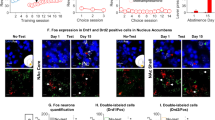Abstract
DRUG self-administration (SA) in laboratory animals shows some of the characteristics of intracranial self-stimulation and of other natural reinforcers (for review see ref. 1). Animals will self-administer many of the same drugs abused by human subjects. Recent evidence has shown that (+)amphetamine reinforces behaviour in the same manner as conventional reinforcers1–3 that it acts mainly on dopamine (DA) transmission, and that locomotor activation and stereotypy are mediated by the mesolimbic–mesocortical (A10 group) and nigro-striatal (A9 group) DA systems, respectively4,5. Using various specific noradrenergic and dopaminergic blocking agents in a (+)amphetamine SA retention paradigm, DA transmission blockade was shown to produce effects similar to reward reduction and reward termination3,6,7. DA transmission in the frontal-mesolimbic system has been implicated in brain stimulation reward8, and the link between self-administration of (+)amphetamine and reward mechanisms, both of which depend on DA transmission, may be related to the craving and early dependence that certain subjects display for addictive drugs. However, the mechanisms which lead to addiction are still unclear, and it is possible that in drug addicts the particularly strong and rapid addicting effect of the drug could be due to a pre-existing imbalance in some homeostatic mechanism. Thus, the use of healthy animals in a steady-state paradigm is not necessarily a good model for the study of the psychological or neurobiological vulnerability to drug addiction acquisition. Because the meso-cortico-limbic DA system may be an essential target for psychostimulant drugs, the lesion of this system could induce disruption of SA behaviour.
This is a preview of subscription content, access via your institution
Access options
Subscribe to this journal
Receive 51 print issues and online access
$199.00 per year
only $3.90 per issue
Buy this article
- Purchase on Springer Link
- Instant access to full article PDF
Prices may be subject to local taxes which are calculated during checkout
Similar content being viewed by others
References
Spealman, R. D. & Goldberg, S. R. A. Rev. Pharmac. Tox. 18, 313–339 (1978).
Pickens, R. & Harris, W. C. Psychopharmacologia 12, 158–163 (1968).
Yokel, R. A. & Wise, R. A. Science 187, 547–549 (1975).
Kelly, P. H., Seviour, P. W. & Iversen, S. D. Brain Res. 94, 507–522 (1975).
Iversen, S. D. & Koob, G. F. Adv. Biochem. Psychopharmac. 16, 209–214 (1977).
Yokel, R. A. & Wise, R. A. Psychopharmacology 48, 311–318 (1976).
Risner, M. E. & Jones, B. E. Pharmac. Biochem. Behav. 5, 477–481 (1976).
Myers, R. D. & Mora, F. Brain Res. Bull. 2, 105–112 (1977).
Le Moal, M., Stinus, L. & Galey, D. Expl Neurol. 50, 521–535 (1976).
Yokel, R. A. & Pickens, R. Psychopharmacologia 34, 255–264 (1974).
Glick, S. D. & Marsanico, R. G. J. comp. Physiol. Psychol. 88, 355–359 (1975).
Lyon, M. & Robbins, T. in Current Developments in Psychopharmacology Vol. 2 (eds Essman, W. & Valzelli, L.) (Spectrum, New York, 1975).
Koob, G. F., Riley, S. J., Smith, C. & Robbins, T. J. comp. Physiol. Psychol. 92, 917–927 (1978).
Roberts, D. C. G., Corcoran, M. E. & Fibiger, H. C. Pharmac. Biochem. Behav. 6, 615–620 (1977).
Le Moal, M., Cardo, B. & Stinus, L. Physiol. Behav. 4, 567–574 (1969).
Galey, D., Simon, H. & Le Moal, M. Brain Res. 124, 83–97 (1977).
Stinus, L., Gaffori, O., Simon, H. & Le Moal, M. J. comp. Physiol. Psychol. 92, 289–296 (1978).
Tassin, J. P. et al. Brain Res. 141, 267–281 (1978).
Stinus, L., Gaffori, O., Simon, H. & Le Moal, M. Biol. Psychiat. 12, 719–731 (1977).
Simon, H. et al. Behav. neural Biol. (in the press).
Philips, A. G. & Fibiger, H. C. Can. J. Psychol. 32, 58–66 (1978).
Author information
Authors and Affiliations
Rights and permissions
About this article
Cite this article
MOAL, M., STINUS, L. & SIMON, H. Increased sensitivity to (+)amphetamine self-administered by rats following meso-cortico-limbic dopamine neurone destruction. Nature 280, 156–158 (1979). https://doi.org/10.1038/280156a0
Received:
Accepted:
Published:
Issue Date:
DOI: https://doi.org/10.1038/280156a0
This article is cited by
-
A multistep general theory of transition to addiction
Psychopharmacology (2013)
-
Long term neurodevelopmental and behavioral effects of perinatal life events in rats
Neurotoxicity Research (2001)
-
Metabolic mapping of the effects of intravenous methamphetamine administration in freely moving rats
Psychopharmacology (1990)
-
Chlorimipramine, electroconvulsive shock and combination thereof: Differential effects of chronic treatment on apomorphine-induced behaviours and on striatal and mesocortical dopamine turnover
Naunyn-Schmiedeberg's Archives of Pharmacology (1985)
-
6-Hydroxydopamine lesion of the dopamine mesocorticolimbic cell bodies increases (+)-amphetamine self-administration
Psychopharmacology (1984)
Comments
By submitting a comment you agree to abide by our Terms and Community Guidelines. If you find something abusive or that does not comply with our terms or guidelines please flag it as inappropriate.



